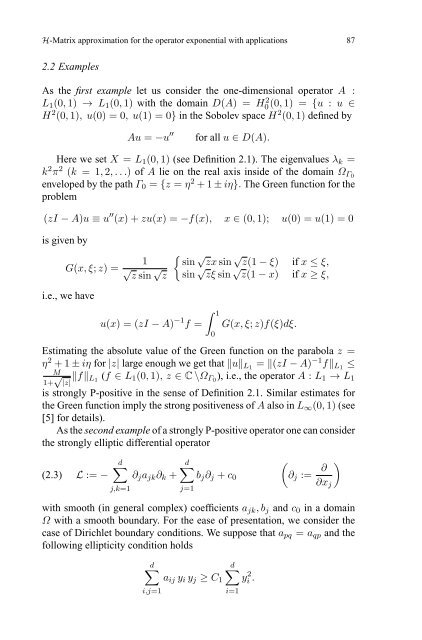H-Matrix approximation for the operator exponential with applications
H-Matrix approximation for the operator exponential with applications
H-Matrix approximation for the operator exponential with applications
Create successful ePaper yourself
Turn your PDF publications into a flip-book with our unique Google optimized e-Paper software.
H-<strong>Matrix</strong> <strong>approximation</strong> <strong>for</strong> <strong>the</strong> <strong>operator</strong> <strong>exponential</strong> <strong>with</strong> <strong>applications</strong> 87<br />
2.2 Examples<br />
As <strong>the</strong> first example let us consider <strong>the</strong> one-dimensional <strong>operator</strong> A :<br />
L 1 (0, 1) → L 1 (0, 1) <strong>with</strong><strong>the</strong> domain D(A) = H0 2 (0, 1) = {u : u ∈<br />
H 2 (0, 1), u(0)=0,u(1)=0} in <strong>the</strong> Sobolev space H 2 (0, 1) defined by<br />
Au = −u ′′<br />
<strong>for</strong> all u ∈ D(A).<br />
Here we set X = L 1 (0, 1) (see Definition 2.1). The eigenvalues λ k =<br />
k 2 π 2 (k =1, 2,...) of A lie on <strong>the</strong> real axis inside of <strong>the</strong> domain Ω Γ0<br />
enveloped by <strong>the</strong> path Γ 0 = {z = η 2 +1± iη}. The Green function <strong>for</strong> <strong>the</strong><br />
problem<br />
(zI − A)u ≡ u ′′ (x)+zu(x) =−f(x), x ∈ (0, 1); u(0) = u(1)=0<br />
is given by<br />
G(x, ξ; z) =<br />
i.e., we have<br />
1<br />
√ z sin<br />
√ z<br />
{<br />
sin<br />
√ zxsin<br />
√ z(1 − ξ) if x ≤ ξ,<br />
sin √ zξ sin √ z(1 − x) if x ≥ ξ,<br />
u(x) =(zI − A) −1 f =<br />
∫ 1<br />
0<br />
G(x, ξ; z)f(ξ)dξ.<br />
Estimating <strong>the</strong> absolute value of <strong>the</strong> Green function on <strong>the</strong> parabola z =<br />
η 2 +1± iη <strong>for</strong> |z| large enoughwe get that ‖u‖ L1 = ‖(zI − A) −1 f‖ L1 ≤<br />
M<br />
1+ √ |z| ‖f‖ L 1<br />
(f ∈ L 1 (0, 1), z∈ C \Ω Γ0 ), i.e., <strong>the</strong> <strong>operator</strong> A : L 1 → L 1<br />
is strongly P-positive in <strong>the</strong> sense of Definition 2.1. Similar estimates <strong>for</strong><br />
<strong>the</strong> Green function imply <strong>the</strong> strong positiveness of A also in L ∞ (0, 1) (see<br />
[5] <strong>for</strong> details).<br />
As <strong>the</strong> second example of a strongly P-positive <strong>operator</strong> one can consider<br />
<strong>the</strong> strongly elliptic differential <strong>operator</strong><br />
(2.3) L := −<br />
d∑<br />
j,k=1<br />
∂ j a jk ∂ k +<br />
d∑<br />
j=1<br />
b j ∂ j + c 0<br />
(<br />
∂ j :=<br />
∂ )<br />
∂x j<br />
<strong>with</strong>smooth(in general complex) coefficients a jk ,b j and c 0 in a domain<br />
Ω <strong>with</strong>a smoothboundary. For <strong>the</strong> ease of presentation, we consider <strong>the</strong><br />
case of Dirichlet boundary conditions. We suppose that a pq = a qp and <strong>the</strong><br />
following ellipticity condition holds<br />
d∑<br />
a ij y i y j ≥ C 1<br />
i,j=1<br />
d∑<br />
yi 2 .<br />
i=1
















